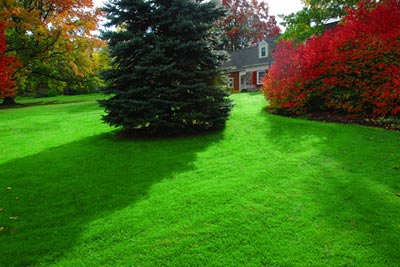Shorter days and cooler nights of late August and early September should mean that your lawn is starting to perk up and look better. The turfgrasses grown in the northern portion of the U.S., such as tall fescue, perennial ryegrass, fine fescue and Kentucky bluegrass, are classified as cool season grasses. Cool season grasses grow best when the air temperatures are in the range of 60° to 75° Fahrenheit. This makes fall an ideal time for lawns to recover from summer stress and to build a strong foundation for a healthy turf for next year.

Proper fertilization is part of the lawn care regimen needed to help your lawn recover from stress this summer and prepare for next year. Fertilizing your lawn in late August or early September will help the grass fill in thin spots, grow a deep root system and store energy (carbohydrates) to survive winter and begin growing early next spring. In addition, fertilizing will provide a deep green color this fall and your lawn will green up early next spring. Our best in class recommendation is our GreenView Fairway Formula Fall Lawn Fertilizer which boasts a 59% slow-release nitrogen formulation.
By fertilizing in late August or early September, it is still warm enough for the grass to take up the fertilizer and utilize it to grow new grass and store energy internally to survive winter and re-grow next spring. Since the air temperatures in fall are cool, there should be only a modest amount of growth - especially if using the GreenView Fairway Formula Fall Fertilizer formulation, as the feeding is slow and steady.
Water your lawn in fall if there are periods of dry weather. The turfgrass will be using water as long as it remains green, so keep watering if there is no rain.
Also, keep mowing your lawn as long as it continues to grow. In most locations this means lawns should be mowed well into November. Use a mowing height of 2.5 to 3.0 inches for a healthy lawn.
Fall is the ideal time to fertilize cool season grasses. Take advantage of the great fall weather to help your lawn recover from stress this summer and to get your lawn off to a great start and early green up next spring.